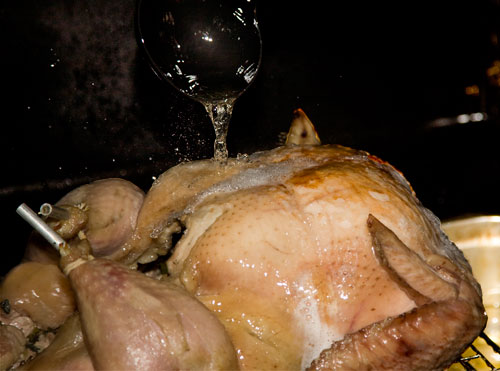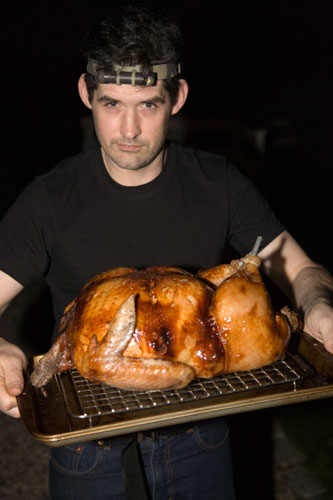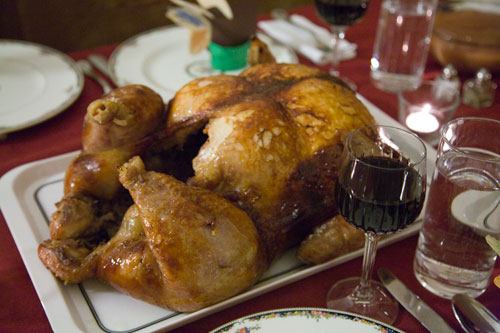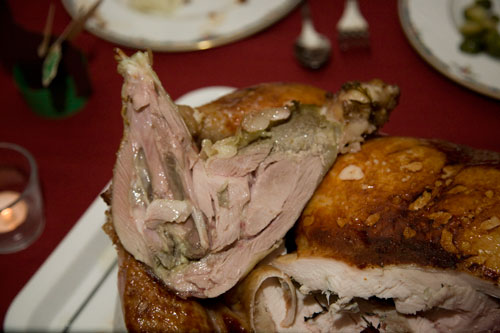posted by Dave Arnold
I hope everyone had a good Thanksgiving, and that your birds turned out well.
Here’s the conclusion to my turkey saga (read the rest here, here, and here):
To recap, I made a boneless bionic turkey with aluminum sprinkler-pipe leg bones and cooked it in duck fat and butter using a two step processs. I chilled it and brought it to my in-laws’ house three hours north of the FCI. All I had to do on Thanksgiving day was warm up the bird and crisp the skin.
Kitchen space was scarce, so I did everything on the grill outside.

I took the bird out of the fridge, removed most of the aluminum foil from its cavity, and let it come up to room temperature for an hour. I turned the grill into a turkey-warmer/pour-over fryer by removing the cooking grates and putting a hotel pan with two gallons of oil directly on the burners. On top of the hotel pan I put a rack to hold the turkey. I put the turkey on the rack and closed the grill (as much as I could) to allow the turkey to warm up while the oil was heating. I couldn’t close the lid without mangling the turkey, so I propped the grill open and tented the lid with aluminum foil. The area where the turkey was sitting floated around 275 F –a good warming temperature.Â

When the oil was piping hot (around 375 F) I started ladling the fat, two-fisted, all over the top of the bird. It browned even faster than I thought it would. The whole bird was crisped up in about 2 minutes. Bonus: there were no spewing geysers of oil, no huge flames, no Thanksgiving-ruining clouds of choking smoke.

So far, so good.

Once inside, I removed the bionic leg bones and the rest of the foil. The bird didn’t collapse. Another win.

The moment of truth:


I was happy with the results. The family enjoyed the bird. Super moist but not watery. Tender. The taste of the herbs, duckfat and butter came through. Next year, I might increase the temperature a half a degree to make the breast meat look a little more conventional. There were also a couple of blood vessels that didn’t lose their red color. That didn’t bother me too much.
Folks around the dinner table kept asking me if it had been “worth it.” Â
 “Did you like it?” I asked.
 “Yes.”
Then I guess it was worth it.

Looking great Dave!! I really enjoyed this saga… can’t wait for next year’s hehehe…
cheers!
i don’t think you should change a thing if you are satisfied with the result. conventional is something to be improved upon. keep up the good work.
Wow! Beautiful! I really wish I could try something like that someday.
Dave, I spy a Zebralight headlamp. Are you a … flashaholic?!?!?
You know it Sygyzy,
I only wish I had more money. The Zebralight is the only flashlight I own that I’m proud of. It is a monster. I bought the H-60 to get the highest output but I’d like to get the 30 or 50 for an even smaller light that takes standard batteries. Most of my work is task-light oriented, but I am thinking of buying another high-quality flashlight that is optimized for throw. Any suggestions? I’d really like to get an H50 or 30 and then mount a Fenix on the side so I could do flood or throw.
What about the bothersome, inedible tendons in the drumsticks? Consider the ballotine.
The tendons are a pain. I took half out and left half in for structure during cooking.
i am def gonna try this out soon, maybe x mas!!! guys i started a new food blog, not your typical boring one, just honest and pure. if you have two seconds can you take a peek and tell me your honest opinion on the blog!!!
thanks
bill http://eatdrinkandroll.wordpress.com/
I was designated this year to make the turkey for a party of around 20 people–too many for a normal-sized single bird, and too much for a single oven. So I decided to make one sous vide, and one traditionally roasted, and have everyone compare.
I decided that since I was already presenting a whole traditional turkey, there was no problem with having the sous vide turkey pre-carved. I ended up cooking the breasts at 60C for about an hour and a half. I did all the rest of the meat in the style of duck confit. I cured it overnight, then cooked it at 80C for 8 hours with some duck fat. After chilling, I crisped up the skin and browned the fat, tediously, in pans, basting with hot duck fat. That step took a ridiculously long time with, for instance, the wings. I again let everything chill, then carved it all. At the party, while the traditional turkey was resting, I gently warmed the sous vide turkey in the oven.
I told everyone to compare the two turkeys, and everyone went wild over the sous vide one. Every single person agreed it was vastly better than the (still pretty darn good) roasted one. Then I told them it was cooked sous vide, and they were all amazed.
Obviously, my dark meat was cooked at much higher temp than yours, and for a vastly longer time. Yet it was not my perception that it was dry or stringy, at least no more than confit always is. Why not?
Howdy Barzelay,
That is interesting. The long term cooking we have done doesn’t fare poorly against traditional cooking, just against shorter low-temp cooking. Dry isn’t the right word. Stringy is closer. It is hard to describe. There is an initial flow of juice but the meat ends up being more fiber-y in the mouth –to our taste. We have run tests on turkeys at 70 C for 8 hours but not 80. Maybe 80 is better? Looks like more tests next year.